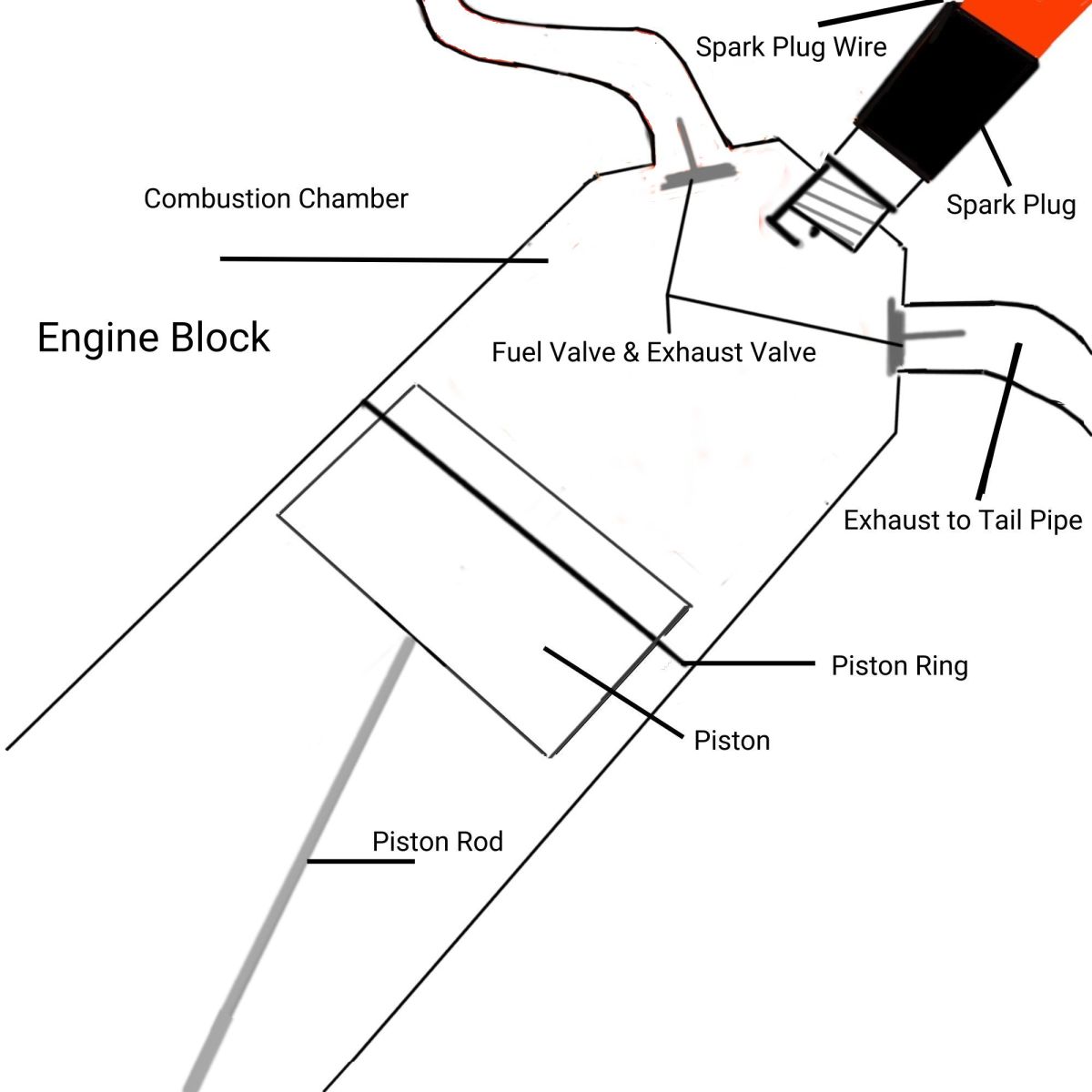Why Are Cars So Hard To Fix? (…or, “What American Car Makers Can Do To Win American Loyalty!)

As a longtime driver—both privately and commercially—something that has been on my mind quite often is the occasional frustration I have with American automobiles. This occasional frustration made another recent appearance to the forefront of my thinking when I was rudely reminded of why I feel this way. I was recently travelling on the interstate returning home from work sometime after 1 in the AM (God, I do so hate 2nd shift) when I noticed the strange way my car’s steering was starting to get noticeably sluggish as I sped along. My weariness had been worn away by the slight anger that was growing in me because I understood what was happening; I was experiencing a flat tire at a most inopportune time (as if there is really an opportune time to have one).
I slowed my car down to a highway snail’s pace, turned on my flashing hazard lights, and attempted to limp the 2-3 miles home I had left to travel. Both my tire and my car however, had other designs. As I drove the home stretch, my tire started growling in that low, angry way tires do when they are “protesting” being driven on without air. The ride started to get even rougher, and I soon got the point my tire (and car) were trying to make; they were refusing to go any further.
So, at something o’clock in the morning, I was forced to get out and attempt to change my tire on the interstate. Here is where the basis for my posting comes in (keep in mind that I had never had previous occasion for changing a tire on this particular car outside of purchasing new tires). I began the ritual of opening my trunk, taking out the necessary implements, and proceeded to slide the tire jack under the troubled wheel to change it out. But when I tried to use the factory-issued lug wrench to loosen the lug-nuts from the wheel, the wrench proved totally ineffective in loosening the lug-nuts.
When I took a few moments to analyze how and why I wasn’t able to budge the lug-nuts from the wheel, I quickly concluded that it wasn’t a lack of physical strength that was the issue, but a lack of effective instruments for the job. The lug wrench provided was less than a foot long (about 30 cm for those of you reading this from another country), and angled in such a way that the designers of this piece of crap “tool” had to be either high or incompetent when they designed it. At any rate, this shortcoming in automobile accessories was (and is) reflective of how American automobile manufacturers are oblivious to the travails and needs of car owners. And it is this reality that that I believe to be the cause of the financial struggles American carmakers have had over the last generations—culminating in the industry’s near-collapse within the last couple of years—in terms of grooming an eager and loyal customer base. The obvious implication is that foreign automakers were besting domestic automakers in both profitability and car owner satisfaction.

The way I see it, American automobile manufacturers would have always had a loyal—and consistently so—customer base not only within the domestic market, but the foreign market as well if they would had built cars that were “owner-friendly.” By this I mean that car owners should have considered going back to the basics of automotive design, whereby we prospective car owners were offered what we needed as well as what was practical. During earlier times, car owners could actually save money by repairing their own vehicles—something needed even now in these lean economic times more than ever. I can remember back in the mid-1980s when I bought my first car, a 1976 Omega Cutlass. Sure, it looked like a piece of crap on the outside, but under the hood—where it really counted—was an engine that was more faithful than a church full of nuns. And having a simple, pre-computerized engine which its high-turnover parts were highly-accessible made maintaining my prized car not only a snap, but made this then 18-year-old feel “manly” knowing that I could actually work on my own car. Back then, I was able to change my own spark plugs, wires, alternator, starter, even the fuel pump (back then, they were located underneath the car’s hood, not inside the fuel tank). Back then, you really didn’t even need a repair manual (even if you did, automobile engines designed were uniformly simplistic, making following any repair manual instructions idiot-proof). You could literally purchase a replacement part for whatever part of an automobile that malfunctioned, and reverse-engineer the repair job by simply eyeballing how the original part was installed.
Cars back then were built with a sense of both appeal and practicality. Automobile makers knew repairs (and maintenance) were inevitable, which is why all cars came equipped with a real spare tire (complete with an inner tube…remember those?), a real tire jack, and a real 4-way lug wrench. Headlights were simple one-piece components you simply plugged into the housing—the headlights literally had a 3-pronged plug on its back which could be changed in 5-minutes.
Today, cars are built with gas and cost efficiency as well as aesthetic appeal in mind. Instead of the heavy metals of yesteryear’s automobiles, they are made of lighter, more aerodynamic metal-like composites materials that crumble like Paper Mache’ when struck. Engine designs are engineered with fuel efficiency as the primary concern. Computerized doodads are able to monitor the car’s engine performance and the power provided by the alternator more efficiently (arguably). What’s more, new government regulations establishing standards for cleaner emissions and mandating better fuel mileage –since the “good ole’ days—spurred many of the (so-called) innovations in automobile design. To its credit, the government’s role in hindering the manufacturing (or is it “eradication”) of owner-friendly cars was warranted…or don’t many of you older types remember the heavy blankets of pollution-fueled smog that covered Los Angeles and many other major cities in the 70s and into the early 80s? Sure, we can whine about “too much government regulation” or “my rights.” But remember…we can’t have our air and breathe it too.
Good intentions notwithstanding, surely that well-touted notion of “American exceptionalism” can spur a way for American automobile manufacturers to design, build, and market an automobile for these lean current lean economic times. Some of us are handy with tools, and don’t mind getting a little bit of dirt and grease underneath out fingernails to keep our rides going. It should not be necessary to remove a front tire to change a battery (as you must do on some American models). Changing headlights should not require an advanced degree in electrical engineering. And dashboards should not light up like a Christmas tree every time some 30-second remedy-type “problem” arises (e.g., a loose gasoline cap. Really…?).
If American automobile manufacturers had maintained the simplicity of easy-to-fix designs, perhaps Detroit wouldn’t have had to deal with a purchasing slump to where they would have needed government bailouts in the first place. As it stands, building complex-designed automobiles gives the impression that automobile makers are out of touch with the needs of the consumer. Any car maker that doesn’t understand how much of an economic strain it is on the average family to scrape up significant amounts of money to replace high-replacement rate parts—without always having to take their cars to the local repair shop—seems to have only one foot in reality. And my personal experience is that others are not as understanding when it comes to the question why are cars so hard to fix?
Most people believe that American automobiles are intentionally designed to give car-owners a great amount of hell if they even think about trying to change a fuse (or something similarly simple). I can’t count how many times I’ve heard people attempting a relatively minor replacement complain about the “conspiracy” by automobile manufacturers to intentionally design cars so that “we would have to take them to a dealer’s mechanic to get them fixed!” However it sounds, it’s not as if it’s hard to deny the plausibility of this belief. What’s more, it’s not as if they don’t have an economic incentive to not make cars easily repairable; that would mean fewer cars purchased over time because we would actually be able to keep our cars running longer.
However, American automobile manufacturers can help both their sales and the consumer’s concern with maintaining the continued function of their all-important means of transportation by using a little common sense owner- (and wallet-) friendly automobiles. The marketing would create itself; an easy to repair automobile would cut down on time and money related to labor that would otherwise be incurred under the current regime. I’m not suggesting that an automobile should be designed in such a way as to have every component easily reparable by a vehicle’s owner. What I am saying is that automobiles are made up of many parts, a lot with high-turnover rates during the lifetime of the vehicle. It just stands to reason that owners (such as myself) with the will and knowhow should not have to have our blood pressures increased just trying to replace such parts—headlights, batteries, starters…and tires!
American automobile makers could corner the global market by simply catering to this practical need of consumers, rather than focusing on “efficiency” and/or aesthetic appeal. Maybe instead of spending billions of dollars on Wall Street advertising to sell us what they think is “hot,” maybe they should ask the consumers what it is that we want. Surely a nation that managed to put a man on the moon can give us both an efficient-operating automobile that’s easy to maintain by the owners?
Would You Choose To Repair Your Own Car If You Could?
- Donate
If you like what you'e read hear, please feel free to contribute to future publications





